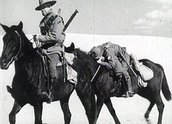


Forty Thousand Horsemen (1940)
Synopsis
Red Gallagher (Grant Taylor) and his best pals Jim (Chips Rafferty) and Larry (Pat Twohill) are bored Australian soldiers in Egypt in 1916, constantly getting up to mischief in Cairo nightclubs. When German-backed Turkish forces attack British outposts in the Sinai desert, the Australians rush to the defence, as mounted troops of the Australian Light Horse regiments. They take part in a fierce battle at Romani, then drive on to Gaza, where Jim and Larry are killed. Red is wounded and lost in the desert, but rescued by a French woman, dressed as an Arab boy. Juliet (Betty Bryant) spies on the German preparations at Beersheba, as Red rejoins his unit in time for the final battle. The Lighthorsemen charge Beersheba across open ground, and are victorious against the odds. Red and Juliet find each other in Jerusalem, after the Turks are routed.
Curator’s notes
Forty Thousand Horsemen was an important film for Australia of the 1940s, both for its director Charles Chauvel, and an Australian public eager for heroic images of its soldiers. Chauvel’s uncle, General Sir Harry Chauvel, had commanded the New Zealand and Australian desert corps in Palestine in the First World War, and Charles had been planning his tribute to the Australian cavalry who fought there since the early 1930s.
Raising the finance had proved difficult, after the failure of Chauvel’s nationalist film Heritage, but Chauvel was nothing if not persistent. When 500 members of the Light Horse paraded in Sydney in early 1938, for the sesquicentenary celebrations, Chauvel arranged to borrow them for a day’s filming. This took place on the sand dunes at Kurnell, near Sydney, on 1 February 1938, with at least four camera units.
The cinematographers on the beach that day included Tasman Higgins, Bert Nicholas, John Heyer, Frank Hurley and Damien Parer – an astonishingly talented crew. Hurley had a pit dug in the sand for himself and his camera, with planks placed over the top, and a small hole left for the lens. His shots of the bellies of horses leaping overhead provide some of the sequence’s most thrilling action. This was the second time in his long career that Hurley had filmed a re-enactment of the famous charge at Beersheba. As a war photographer in Palestine in 1918, he had set up and filmed a re-enactment of the charge using troops of the Australian Light Horse (though not the same ones that actually made the charge). That film is now believed to be lost.
The charge provides a powerful and violent conclusion to what is certainly Chauvel’s best film to that date, perhaps second only to Jedda. It’s still an exciting action sequence almost 70 years later, and it helped make the film an Australian, then an international, hit. It opened in Sydney on 26 December 1940, ten months after the first Australian troops had arrived in the Middle East to take part in the Second World War. The film was very clearly a propaganda weapon, to aid recruitment and swell the pride of Australians at home.
Chauvel created his version of the ideal digger with his trio of larrikins, introducing a very young and fresh-faced Chips Rafferty, who modelled himself in part on the comical digger created by Pat Hanna (see the film Diggers). Chauvel never mentions his uncle’s role in the battles, because he didn’t want the film to be seen as a family tribute.
After the extremely lean years of the 1930s, the success of Forty Thousand Horsemen helped Chauvel to keep making films throughout the war years, when feature production all but shut down. His next film was The Rats of Tobruk, made in 1944, with many of the same actors.
- Overview
- Curator’s notes
- Video 3 clips

- Principal credits
- Find a copy
- Comments 3
- Add your review



